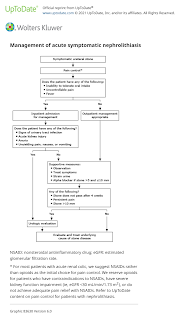Kidney Stones
Introduction
Kidney stone disease (nephrolithiasis) is a common problem in primary care practice.
- The stones are formed on the inner surfaces of the kidneys when the urine becomes too concentrated, causing the minerals and other substances in the urine to crystalise. These crystals then tend to combine in time, forming a mass, known as kidney stones or renal calculi.
Symptoms
Patients may present with the classic symptoms of renal colic and haematuria. Others may be asymptomatic or have atypical symptoms such as
- Vague abdominal pain
- Acute abdominal or flank pain
- Nausea
- Urinary urgency or frequency
- Difficulty urinating
- Penile pain
- Testicular pain
NOTE: Patients are often asymptomatic until a stone causes partial, intermittent, or complete obstruction, resulting in acute and potentially debilitating renal colic.
Acute Management
In general, if patients can take oral medications and fluids, they can be managed at home.
Supportive measures include
- Hydration until the stone passes
- Pain control with NSAIDs or paracetamol
- Treat urinary tract infection if present
Stone passage
- Stone size is the major determinant of the likelihood of spontaneous stone passage, although stone location is also important.
- Most stones ≤5 mm in diameter pass spontaneously.
- For stones larger than 5 mm in diameter, there is a progressive decrease in the spontaneous passage rate, which is unlikely with stones ≥10 mm in diameter.
NOTE: Hospitalization is required for those who cannot tolerate oral intake or who have uncontrollable pain or fever. Urgent urologic consultation is warranted in patients with urinary tract infection, acute kidney injury, anuria, and/or unyielding pain, nausea, or vomiting.
Expulsive Therapy
In patients with ureteral stones >5 mm and ≤10 mm in diameter, may consider medical expulsive therapy with the alpha blocker (e.g. tamsulosin, alfuzosin, doxazosin, silodosin and terazosin) [off-label] to facilitate spontaneous stone passage.
- Calcium channel blockers: Studies directly comparing nifedipine with tamsulosin have reported lower stone passage rates, longer stone expulsion times, and more complications with nifedipine.
- Other agents: Tadalafil
Surgical means are used when the stones are too big.
- Ureteroscopic stone removal
- Shockwave lithotripsy (SWL)
- Retrograde intrarenal surgery (RIRS)
- Percutaneous nephrolithotomy (PNL)
External Links
- UpToDate - Kidney stones in adults: Diagnosis and acute management of suspected nephrolithiasis
- Time to stone passage for observed ureteral calculi: a guide for patient education, 1999
- Role of tamsulosin, tadalafil, and silodosin as the medical expulsive therapy in lower ureteric stone: a randomized trial (a pilot study), 2015
- Nonsteroidal anti-inflammatory drugs (NSAIDs) and non-opioids for acute renal colic, 2015
- Comparative efficacy of tamsulosin versus nifedipine for distal ureteral calculi: a meta-analysis, 2016
- A Systematic Review and Meta-analysis Comparing the Efficacy of Nonsteroidal Anti-inflammatory Drugs, Opioids, and Paracetamol in the Treatment of Acute Renal Colic, 2018

Comments
Post a Comment